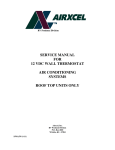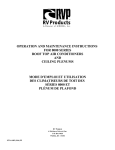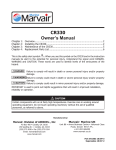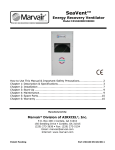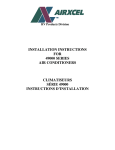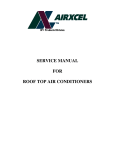Download RV Products 6700 Series Operating instructions
Transcript
INSTALLATION AND OPERATING INSTRUCTIONS FOR 7330B4101 SOLAR POWERED BATTERY MAINTENANCE KIT TABLE OF CONTENTS I. II. III. IV. V. VI. VII. General Information . . . . . . . . . . . . . . . . . . . . . . . . . . . . . . . . . . . . . . . . . . . . . . . . Installing on 6700 Series Air Conditioners . . . . . . . . . . . . . . . . . . . . . . . . . . . . . . Installing on 7000, 8000, 48000 Series Air Conditioners . . . . . . . . . . . . . . . . . . . Installing on 47000 Series Air Conditioners . . . . . . . . . . . . . . . . . . . . . . . . . . . . . Ceiling Assembly Wiring . . . . . . . . . . . . . . . . . . . . . . . . . . . . . . . . . . . . . . . . . . . . Wiring to the Battery . . . . . . . . . . . . . . . . . . . . . . . . . . . . . . . . . . . . . . . . . . . . . . . Operating Instructions . . . . . . . . . . . . . . . . . . . . . . . . . . . . . . . . . . . . . . . . . . . . . . 2 3 5 7 9 10 10 These instructions are a guide for installing and operating the 7330B4101 Airxcel, Inc. Solar Powered Battery Maintainer on all 6700, 7000, 8000, 47000 and 48000 series roof top air conditioners, except the Super Mach and Delta T models. IMPORTANT NOTICE WARNING – SHOCK HAZARD These instructions are for the use of qualified individuals specially trained and experienced in installation of this type equipment and related system components. To prevent the possibility of severe personal injury or equipment damage due to electrical shock, always be sure the electrical power to the appliance is disconnected. Installation and service personnel are required by some states to be licensed. PERSONS NOT QUALIFIED SHALL NOT INSTALL NOR SERVICE THIS EQUIPMENT. CAREFULLY FOLLOW ALL INSTRUCTIONS AND WARNINGS IN THIS BOOKLET TO AVOID DAMAGE TO THE EQUIPMENT, PERSONAL INJURY OR FIRE. NOTE WARNING The words “Shall” or “Must” indicate a requirement which is essential to satisfactory and safe product performance. Improper installation may damage equipment, can create a hazard and will void the warranty. The words “Should” or “May” indicate a recommendation or advice which is not essential and not required but which may be useful or helpful. The use of components not tested in accordance with these units will void the warranty, may make the equipment in violation of state codes, may create a hazard and may ruin the equipment. I. GENERAL INFORMATION INSTALLER AND/OR DEALER – Please make sure these operating instructions are presented to the product consumer. INQUIRIES ABOUT THE A/C UNIT – Inquiries to your Airxcel, Inc. representative or to Airxcel, Inc. pertaining to product installation should contain the model number of the roof top air conditioner. All roof top air conditioning units have model number identification in two locations: (1) rating plate sticker which may be viewed by looking through the shroud louvers on the compressor side of the roof top air conditioning unit. The rating plate sticker can be seen without removing the outer plastic shroud. NOTE: On the 47000 series roof top unit, it will be necessary to remove the outer plastic shroud to view the rating plate; (2) model/serial number sticker (silver or white in color) is located on the bottom of the basepan of the roof top air conditioner. If the air conditioner is installed, the sticker may be viewed by lowering the ceiling assembly shroud. Contents of Kit: 1) 2) 3) 4) 5) 6) Solar Panel Assembly Solar Harness Assembly (Long) Ceiling Harness Assembly (Short) 20’ Connector Cable Assembly Installation and Operating Instructions Small Parts Package Consisting of: a) Edge Liner b) Strain Relief Bushing c) Split Bushing d) Neoprene Lined Steel Clamp e) 2 Wire Ties f) 2 Screws g) 2 Nylon Spacers -2- II. INSTALLING ON 6700 SERIES AIR CONDITIONERS WARNING – SHOCK HAZARD in the wire harness and insure that no wires can come into contact with the refrigerant copper lines or any sharp edges. To prevent the possibility of severe personal injury or equipment damage due to electrical shock, always be sure the electrical power to the appliance is disconnected. 8. Remove and discard the strain relief bushing found in the side panel (refer to Figure 1). Route the solar harness through the hole in the side panel. Allow approximately 8” of slack harness wire inside the wire box and secure all wires to the side panel using the strain relief found in this kit. It may be necessary to wrap the wire bundle with electrical tape to provide a snug fit. 9. Route the white connector plug through the opening in the basepan along with the existing unit wiring bundle. Push through all remaining harness wiring so as to leave a minimum of slack harness in the upper unit. 10. Before reinstalling the evaporator cover, insure that all system wires are routed and secured to provide protection against contact with sharp edges, refrigerant tubing or moving parts. Insure that no wires are pinched between metal parts or surfaces, or can be pierced by assembly fasteners during unit reassembly. If necessary, use wire ties to provide wiring security. 11. Before installing the shroud, position the trailer plug and solar harness outboard of the condenser coil so that it may be routed through the condenser air inlet of the shroud as the shroud is being reinstalled (See Figure 1). The harness will be trapped between the shroud foam blocks and the edge liner after installation. 12. Position the nylon spacers and the solar panel assembly as shown in Figure 1 and assemble to the roof top air conditioner unit with the acorn nuts and washers previously removed in Step 2. 13. Insert the plug on the solar panel assembly into the solar harness plug until they are fully engaged. To install the solar panel and through-way wiring of this kit to the 6700 series Mach 1, II or III air conditioners, perform the following steps (refer to Figure 1). Reminder: This kit is not for use on Super Mach or Delta T air conditioners. 1. If the air conditioner is a new installation, follow instructions found with the air conditioner to complete the unit installation. 2. Remove the upper unit shroud by removing the four acorn nuts and steel washers. 3. Remove the sheet metal screws securing the evaporator cover and set aside the cover. Take care in handling sheet metal edges as they can be quite sharp. 4. Using the neoprene lined steel clamp provided in this kit, secure the upper unit wire harness (Solar Harness Assembly Long) to the condenser panel as shown in Figure 1. Allow 24” between the clamp and the end of the trailer plug. NOTE The trailer plug is provided with a blocking diode molded in and will pass current in one direction only. Keep this in mind if checking the upper unit wire harness for continuity. 5. 6. 7. Attach the protective edge liner to the condenser flange by forcing the liner onto the metal edge as shown in Figure 1. Insure that the edge liner is securely installed. Cut off any excess edge liner length which may extend beyond the condenser header plate. Use a diagonal cutter for this purpose as the edge liner contains spring steel sections. Wear eye protection when cutting edge liner. Optional: Spray the connection with a good quality spray to protect against corrosion. This type of product is readily available at most auto supply or hardware outlets for protection of rubber and thermoplastic insulated wiring. Remove and discard (cut with diagonal cutters or metal snips) the edge protector bushing entering the wire box. Take care to prevent nicking any wire insulation. Route the white connector plug end of the solar wire harness through the wire box entry hole. Using the split bushing found in this kit, surround all wires entering the wire box and snap the new bushing into the wire box. Clean the solar panel glass surface with any good quality glass cleaner (non-abrasive) to remove any smudges or fingerprints encountered during handling. Using a wire tie provided in this kit, wire tie the upper unit wire harness to the compressor motor wires entering the unit wire box. Take up all slack Installation of the upper unit through-way wiring is now complete. -3- FIGURE 1 -4- III. INSTALLING ON 7000, 8000 AND 48000 SERIES AIR CONDITIONERS WARNING – SHOCK HAZARD 8. Route the solar harness under the evaporator drain pan along with the system wiring harness. Wire tie the solar harness to the system wiring bundle. It will be necessary to gently pry up the drain pan to fish through the white connector plug. Take up all solar wire harness slack wire and drop the harness end into the return air opening of the basepan. Insure that the drain pan is not out of position over the pan outlet after completion of wiring. To prevent the possibility of severe personal injury or equipment damage due to electrical shock, always be sure the electrical power to the appliance is disconnected. To install the solar panel and through-way wiring of this kit to the 7000, 8000 and 48000 series air conditioners, perform the following steps (refer to Figure 2). 1. If the air conditioner is a new installation, follow instructions found with the air conditioner to complete the unit installation. 9. Reinstall all panels, taking care to avoid piercing tubing or wiring with assembly screws or pinching wiring between panels. 2. Remove the upper unit shroud by removing the four stainless steel screws and black nylon washers. 10. 3. Remove the sheet metal screws securing the evaporator cover and set aside the cover. Take care in handling sheet metal edges as they can be quite sharp. Before reinstalling the shroud, position the trailer plug and solar harness outboard of the condenser coil so that it may be routed through the condenser air inlet of the shroud as the shroud is being reinstalled (See Figure 2). The harness will be trapped between the shroud foam blocks and the edge liner after installation. 4. Remove the left side panel and wire box cover (as shown in Figure 2) and set aside. 11. 5. Using the neoprene lined steel clamp provided in this kit, secure the upper unit wire harness (Solar Harness Assembly Long) to the condenser panel as shown in Figure 1. Allow 24” between the clamp and the end of the trailer plug. Position the nylon spacers and the solar panel assembly as shown in Figure 2 and assemble to the roof top air conditioner unit with the stainless steel screws and nylon washers previously removed in Step 2. 12. Insert the plug on the solar panel assembly into the solar harness plug until they are fully engaged. Optional: Spray the connection with a good quality spray to protect against corrosion. This type of product is readily available at most auto supply or hardware outlets for protection of rubber and thermoplastic insulated wiring. NOTE The trailer plug is provided with a blocking diode molded in and will pass current in one direction only. Keep this in mind if checking the upper unit wire harness for continuity. 6. 7. Clean the solar panel glass surface with any good quality glass cleaner (non-abrasive) to remove any smudges or fingerprints encountered during handling. Attach the protective edge liner to the condenser flange by forcing the liner onto the metal edge as shown in Figure 2. Insure that the edge liner is securely installed. Cut off any excess edge liner length which may extend beyond the condenser header plate. Use a diagonal cutter for this purpose as the edge liner contains spring steel sections. Wear eye protection when cutting edge liner. Installation of the upper unit through-way wiring is now complete. Route the solar harness along the liquid line and capillary tube(s) and through the foam blocks as shown in Figure 2. Secure the solar harness to the large refrigeration line (suction line) using a wire tie found in this kit. It may be necessary to remove and reinstall the foam blocks in order to route the solar harness through the blocks. -5- FIGURE 2 -6- IV. INSTALLING ON 47000 SERIES AIR CONDITIONERS 6. Route the solar harness along the system wiring harness. Wire tie the harness to system wiring bundle. Take up all solar harness slack wire and drop the harness end into the return air opening of the basepan. To install the solar panel and through-way wiring of this kit to the 47000 series air conditioners, perform the following steps (refer to Figures 3 and 4). 7. Reinstall the evaporator cover using the keps nuts, taking care to avoid pinching wiring between evaporator cover and basepan wall. 1. If the air conditioner is a new installation, follow instructions found with the air conditioner to complete the unit installation. 8. Reassemble the upper unit shroud, inserting the trailer plug from the solar harness through the drilled hole. 2. Remove the upper unit shroud by removing the four stainless steel screws and washers. 9. Insert the plug on the solar panel into the unit cable plug until they are fully engaged. 3. Remove the four keps nuts securing the evaporator cover and set aside the cover. 10. 4. Referencing Figure 3, scribe two arcs on shroud and drill a 1 ¼” inch diameter hole at the arc intersection. This hole is for the solar panel assembly wiring. Insert the plug connection into the hole in the shroud. It may be necessary to lift the shroud up to provide clearance for the plugs between the shroud and the evaporator housing. 11. Secure shroud in place by reinstalling the back two stainless steel screws and washers. 12. Using the two washers as spacers on the plug end of the solar panel, reassemble the two screws through the holes in the solar panel plate and into the threaded inserts of the roof top unit. 13. Clean the solar panel glass surface with any good quality glass cleaner (non-abrasive) to remove any smudges or fingerprints encountered during handling. Installation of the upper unit through-way wiring is now complete. WARNING – SHOCK HAZARD To prevent the possibility of severe personal injury or equipment damage due to electrical shock, always be sure the electrical power to the appliance is disconnected. 5. Remove the neoprene lined clamp shown in Figure 4. Place the solar harness assembly (long) with the unit wiring bundle, allowing 24” between the clamp and the end of the trailer plug. Reinstall the neoprene lined clamp securing the solar harness assembly with the unit wiring bundle. NOTE The trailer plug is provided with a blocking diode molded in and will pass current in one direction only. Keep this in mind if checking the upper unit wire harness for continuity. FIGURE 3 -7- FIGURE 4 -8- V. CEILING ASSEMBLY WIRING (ALL MODELS) 1. Remove the inside ceiling assembly shroud or grille. The ducted system grille is attached with four screws (one near each corner). Free delivery system shrouds are attached with two screws (one each end). Ducted system grille is shown in Figure 5. 2. The short wire harness assembly found with this kit must install onto the ceiling grille or shroud through the return air section. Ducted system grilles are totally in the return air stream. Choose any square opening which will allow the wire assembly to be untouched by sheet metal members when the grille is reinstalled. The plastic plug will route through the selected square opening. The remainder of the assembly will be pulled through the opening until the jack at the opposite end of the harness is through the opening and prevented from further travel by the stainless washer, which will not pass through the grille. Carefully bend over the aluminum tabs on either of the jack so as to capture the jack in the ceiling assembly (See Figure 5). Make a small opening in the filter material to allow passage of the wiring before attaching the filter. Connect the plastic plug to the mating receptacle on the end of the upper unit solar wire harness. Reinstall the ceiling grille, taking care that any excess harness wiring is prevented from contacting sharp edges or being pinched between two members. Use wire ties or electrical tape if necessary to insure wire security. Installation onto a free delivery system shroud is similar to the method for grille attachment except that the shroud return air louvers are longer and somewhat narrower. The jack will fit snugly between two louvers and slightly spread them apart. Orient the aluminum tabs so as to capture the jack before bending over the tabs. Again, insure that the jack or wiring will not interfere with any structures upon reassembly of the shroud. FIGURE 5 -9- VI. WIRING TO THE BATTERY In most cases, the recreational vehicle will be provided with a 12 VDC receptacle which is wired to the battery circuit, usually a cigarette lighter. Insure that during storage, when all 12 volt loads have been shut off, that the manufacturer supplied receptacle maintains a path to the battery. This fuse protects the wiring between the battery and the receptacle. (A ½ amp fuse is provided in the male plug on the 20’ connector cable assembly to protect wiring to the solar panel.) Insure that the receptacle is covered or otherwise protected against accidental insertion of any conductive material during storage. Allowing a conductive material to enter the receptacle would create a short circuit which would result in a blown fuse. If a receptacle is not provided, one can be obtained from almost any auto supply or recreational vehicle supply retailer. To protect against wire damage and fire, a fuse must be provided in the receptacle wiring. Recommended maximum fuse size is 5 amps, minimum fuse size is ½ amp. Route wires to the battery so as to avoid chafing or pinching and secure all wiring to avoid loose wires which might be snagged during travel. VII. OPERATING INSTRUCTIONS To activate – first connect the 20’ connector plug into the ceiling assembly and verify that the male 12V plug indicator illuminates. Next, temporarily disconnect the plug and connect the 12 VDC male plug into the battery cable receptacle to verify by the lighted indicator on the plug, that there is a good connection to the battery. After verifying the connections, reconnect the ceiling assembly. The solar panel will now automatically charge the battery during sunlight. A blocking diode prevents battery “back feed” into the solar panel at night. Airxcel, Inc. supplies custom engineered photovoltaic systems using the highest quality components available. To enjoy the maximum benefit from your solar maintenance system, please take a few moments to read the important information in this section. The Problem When not in use over a period of time, the house battery for a motor home will naturally “self-discharge”. This is true even when the battery disconnect switch is open, preventing any power draw. Batteries allowed to self-discharge can result in “sulfation”, a condition which results in permanent damage, decreasing the effective life of the battery. It is not always convenient to run power for battery maintenance to where a motor home is stored, and it is even less convenient to remove and relocate the battery each time the motor home will be stored. How Your System Works Solar electric generation (technically known as photovoltaic power) is the technology of producing electricity directly from sunlight. Your solar charging system is 100% “Solid State” – meaning that there are absolutely no moving parts when solar charging occurs. This maintenance kit provides a single 5 watt solar panel mounted on top of the Coleman®-Mach® air conditioner shroud, located on the roof. This panel generates enough power to maintain the charge on your house battery at its last operated charge value only during storage, but is selfregulating in power output to prevent overcharging the battery. The Solution Your solar electric maintenance system provides an ideal method of keeping your battery maintained during storage. All that is required to keep a full charge on the house battery is for your RV to be stored where the solar panel is exposed to direct sunlight. When kept properly charged, your house battery will provide many years of trouble-free performance. Your solar panel will operate even on cloudy days or with partial shading, although the amount of charging power generated will be reduced. Operation In total darkness, the solar panel and monitor will not discharge the battery in any manner because of our special circuit design. Your solar maintenance system will operate any time the solar panel is exposed to sufficient sunlight and the connector cable assembly has been connected between the ceiling assembly and the battery receptacle. If your RV is equipped with a battery disconnect switch, be certain that it is open (in the “disconnect” position) while the motor home is stored. This will insure that the solar maintenance can continue to charge the house battery without a power draw from lights, appliances, etc. Maintenance Your solar panel is virtually maintenance free. Occasional cleaning of the solar panel will assure optimum performance. Simply use the same product used for cleaning your windshield, avoiding harsh chemicals. During winter months, accumulation of snow will reduce the effectiveness of the panel and should be carefully brushed away. No other maintenance is required. Your solar maintenance system cannot overcharge the battery. -10- During daylight hours, unplug the charger. Performance Limitations Your solar maintenance system is designed to generate enough power to maintain the charge on your house battery at its last operated charge value only during storage when all devices and appliances are off (or when so equipped, the battery disconnect is activated). It will not maintain the charge on a battery which is subject to discharge by any type of power draw, nor is it powerful enough to recharge a discharged battery. 1) If the red light is illuminated, the problem is probably in the house battery to the 12 VDC outlet. a) 2) Safety Considerations DO NOT connect additional solar panels or modify the wiring for this system. The solar monitor is designed specifically for a low power level and an increase in power will likely result in serious damage to the unit. DO NOT sit or stand on the panel. The panel is not designed to withstand this type of weight and may crack, resulting in personal injury. Replace the panel if it becomes damaged, cracked or broken. Broken or cracked glass on a damaged panel is a hazard and may result in personal injury. Check the fuse where the solar system 12 VDC outlet connects to the house battery. If the red light is not illuminated, the problem is probably in the solar panel system. a) Check to see if the solar panel is damaged or missing. b) Check the connection at the solar monitor to insure that it is properly connected. c) Check fuse inside the 12 VDC male plug. Fuse is accessed by pushing in on the plug tip and turning ¼ turn. Fuse is rated at ½ amp. Service For repair, visit your authorized service center. If you have additional questions or need additional assistance, please call our Customer Service Technical Department at 316-832-4357. Troubleshooting The red light on the cable assembly plug should illuminate whenever the solar panel on the roof of the motor home is exposed to sunlight and/or the charger is connected to the house battery. If the light does not illuminate: -11- Airxcel, Inc. RV Products Division P.O. Box 4020 Wichita, KS 67204 1976D182 (12-12) PP












